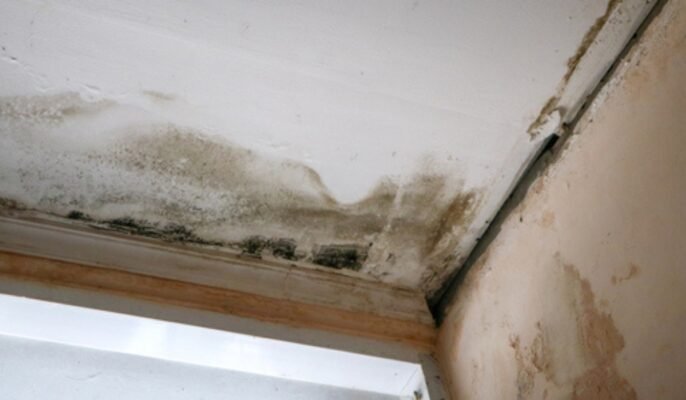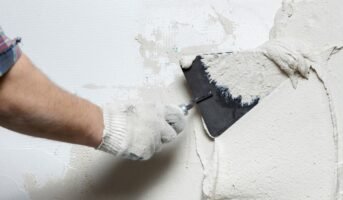For many residences, leakage from pipes, plumbing fixtures, and fittings is a substantial cause of water waste. Dripping faucets and leaking water heaters are two examples of leaks that are easy to spot. Unfortunately, a lot of leaks go undiscovered for years since the leakage source is invisible. It is frightening to have an unforeseen leak. Until the source is identified and fixed, it is impossible to determine the amount of the problem or harm being caused. Don’t panic if you think there might be a water leakage inside a wall—you might be able to fix it yourself without spending a lot of money on repairs or any substantial maintenance.
Source: Pinterest
Water leakage: What is it?
Water leakage is the process by which liquids (mainly water) seep into your home through porous materials, cracks, and crevices, leaving damp stains on the walls and ceilings that give them an unattractive aspect.
Water leakage in a home can damage your house in ways you couldn’t even imagine. Leakage harms the paints and plasters on the interiors and exteriors, in addition to having a terrible appearance. Additionally, it results in wet floors, walls, and ceilings. Consequently, it won’t come as a surprise if you frequently catch a cold while staying in such a place.
If water leaks are ignored, both the outside and interior appearances of the property are negatively impacted. Because of this, homeowners should give waterproofing solutions a priority to eliminate or lessen troubles brought on by water leakage and take proactive measures to damp proof and waterproof their properties before things get out of hand.
Water leakage: Importance of water leakage detection
Water leak detection and waterproofing are two of the most significant yet unaddressed challenges due to the lack of exposure to concrete technology. It is frequently dismissed as a mild inconvenience rather than a serious problem. Delaying it, however, will make the issue worse and leave your wall drenched in water, giving your home a hideous sight.
Get the following advantages by finding water leaks as soon as you can:
- Water damage to interiors is avoidable.
- Prevents the beginning of health problems.
- It helps in financial savings.
- Provides long-term comfort.
Flow guard: Detect water leaks
Hidden signs
Before noticing any leakage, odour and humidity may alert you to unseen indicators of water damage in walls. Mildew may be caused by water from a leak inside a wall or between your subfloor and the finished floor if you return home after a lengthy trip and smell mildew. If the air in your home seems unusually wet, it might be possible that a small leak somewhere in the house could be letting in gallons of moisture, causing this issue.
Other signs to keep a watch out for without actually seeing them include:
- Defective pipelines
- Faulty drainage
- Wet or soggy flooring
Visual evidence
Anything you notice, even in the lack of particular evidence, clearly indicates a water leak:
- Deteriorated or faded roofs
- Holes and cracks in the kitchen wall
- Bathroom walls with scratches
- Baseboards and mouldings that are curling away from the wall
Water leakage: How to deal with it?
Exterior
The majority of homeowners have, at some point, dealt with an inside leak. However, it’s equally crucial to keep an eye out for leaks that emerge on your outside walls. If you recently stepped outside and noticed water dripping from your property, you must act right away.
What to do?
- Caulk should be used to treat moisture.
- Apply stucco.
- Contact a professional repairing service.
Interior
Cracks first show up on ceilings or in the areas surrounding doors and windows when inner wall leaking first begins. It is important to keep in mind that if left unattended, damage and fractures on exterior walls might eventually result in water leakage on the ceiling and dampness in interior walls. The use of cheap and low-quality paints is another factor contributing to wall leakage within homes.
What to do?
- For wall leakage repair, use high-quality water-resistant paints with silicon or other reinforcing constituents.
- Make sure the seams between the window/door frame and the wall are sealed.
- With the help of cement, plaster, and other water-resistant materials, cracks and fissures should be mended.
Roof
Water leaking from the roof is unquestionably a nightmare. Nobody enjoys having water dripping frequently from their roof, and these ceiling leaks could potentially harm your property and health. Once you have identified the major cause of the leak, there are a few simple yet effective treatments for your roof. Therefore, it is preferable to stop any water leaks from the ceiling as soon as possible.
What to do?
- Find the leaky spot
- Shake the shingles off
- Use caulk to fix a roof that is damaged
- Use roof leak prevention tools
- Tar should be used to patch the hole
- Waterproofing for terrace
Drip safe: Prevent water leaks
- Monitoring all appliances regularly helps prevent water leakage.
- Replace older parts of the hardware from where water may leak before it happens.
- Check your water bill. If you see any increase in it that is not towards your water consumption, check for water leaks.
- Check for risks in winter such as frozen water pipes that may burst resulting in water leakage.
AquaLeak: Monitor water leakage
Use leak detection system – moisture sensors or whole home systems to detect and prevent water leakage.
FAQs
What is the water leakage?
Water leakage is when water seeps into your home through gaps and fractures. These leave moisture spots on the walls and ceilings and slowly erode the entire foundation.
What is the main cause of water leakage?
The points from where pipes connect are mostly weak and are most prone to damage.
What is the risk of water leak?
The risk of water leak is presence of stagnant water which may lead to many diseases.
Where are most water leaks?
Kitchen and bathroom Faucets are the places where most water leaks happen.
How long does it take to fix a water-damaged wall?
Larger water-damaged sections call for longer drying times. No matter how much of an area was affected, you must follow specific steps to improve the interior of your home. All the water may evaporate in 72 hours, but it may take weeks to repair all the damage.
What can be done to stop water leakage?
Simple water management techniques could include drilling relief holes into the composite wall construction, cutting a slot or aperture into the floor slab next to the footing or wall leaking area(s), and then directing the collected water to a nearby drain.
| Got any questions or point of view on our article? We would love to hear from you. Write to our Editor-in-Chief Jhumur Ghosh at jhumur.ghosh1@housing.com |
Priya Banerjee, a writer with a keen eye on the property market, she deciphers the ever-changing trends in residential real estate. Priya excels at simplifying complex real estate terms, making them easy for everyone to understand. Her well-researched advice helps buyers and investors understand complex topics.

